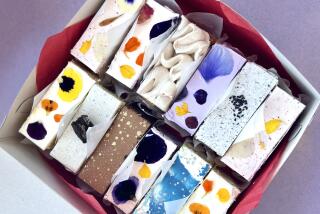Celebrating the new year with a taste of the past
Customers crowded into the Tan Hoang Huong bakery in Santa Ana several days before the lunar new year. Gifts of candies and dried fruit wrapped in red cellophane lined the walls. And the sweet fragrance of banh chung, rice cakes wrapped in banana leaves and stuffed with mung beans and pork belly, filled the air.
Ailinh Nguyen had already picked up nine banh chung that she planned to give to her parents and friends, then realized she wanted one more for herself in time for Tet, the Vietnamese lunar new year. So she drove from her home in Mission Viejo back to the bakery Thursday afternoon and squealed with delight as she snapped up the last cake on the counter.
“During Tet, you have to eat banh chung because it’s tradition,” Nguyen said. “I love the taste of banh chung, but to me, [it] tastes more tasteful during Tet.”
The lunar new year, which will be celebrated Sunday, is regarded as the most important cultural holiday among Vietnamese, Chinese and some Koreans. This year they will be welcoming in the Year of the Tiger.
Bringing in the Vietnamese lunar new year without banh chung is like celebrating Thanksgiving without a turkey. The five-pound square rice cakes, the color of jade when opened, are seen in nearly every Vietnamese household.
In the homeland, families and friends gathered in villages to prepare batches of the sticky cakes by hand, taking turns sleeping to tend to the stove, because the cakes take more than 10 hours to cook. But in America, life is busier and the celebrations are shorter, so Vietnamese Americans rely on bakeries that specialize in the cakes.
“You don’t make a lot of money selling banh chung,” said Lan Luu, 40, whose family owns the bakery. “But we enjoy selling it because it gives us the feeling of Tet.”
The cakes are based on a legend in which a dying king must choose among his sons for a successor depending on who made the tastiest and most meaningful dish. His youngest son was poor and couldn’t afford ingredients to make a lavish meal. Instead, he made a cake with simple ingredients: rice, beans and pork.
The son presented the king with banh chung, which is square, representing land, and banh day, made with the same ingredients but round, symbolizing the sky. He was declared the winner.
In the early 1980s, the rice cakes were rare on the streets of Orange County’s Little Saigon, home to the largest concentration of Vietnamese in the country.
Vietnamese Americans were just beginning to settle in the Westminster area after the Vietnam War. Ingredients were not easy to find and equipment was scarce. “People would buy any size and shape,” Luu said. “They didn’t look very nice back then.”
So Luu and her husband’s family began to prepare the cakes. Her sister-in-law, Dung Dong, had learned to make banh chung in the seaside city of Vung Tau when she was a young girl.
The family toiled in the kitchen for weeks before the holiday and sold the green bundles to Vietnamese markets.
They eventually opened a bakery to sell banh chung during Tet, along with other new year delicacies. Unable to find pots large enough to fit the cakes, Luu’s husband, Tom Dong, constructed the equipment the bakery now uses, including a 4-foot-tall metal pot that can accommodate more than 100 cakes.
The bakery has been preparing for Tet for a month. Making banh chung is a painstaking process, and Tan Hoang Huong makes about 5,000 during the lunar new year.
Workers spend the day preparing ingredients: marinating pork belly with scallions, cooking the yellow mung bean, soaking the sticky rice and washing banana leaves.
Dung Dong wrapped the last of the cakes several days before Tet.
She put four layers of banana leaves in a square wooden mold and added layers of rice, mung beans and pork.
She pressed down on the leaves and wrapped the bundle tightly so water cannot seep through.
The cakes are then wedged into a large metal pot and boiled for 10 hours. Luu’s husband and brother-in-law stay up all night to watch the fire and add water.
“Not many people have the time to do that,” Luu said. “It’s a lot of work.”
Once the cake is done, the bundle is wrapped in a red ribbon. Each 6-inch by 6-inch cake sells for $12 to $15.
Although making the cakes is a lot of work, Luu said she’s happy that banh chung brings Vietnamese Americans the spirit of Tet, leaving behind regrets of the past and sweeping in the new year.
“There isn’t as much feeling of Tet in the U.S. Sometimes it falls on a weekday and people can’t take time off work and they don’t get to see relatives. In Vietnam, there is weeks of preparation and celebration,” she said. “But with banh chung, people give it to their friends and relatives and they can celebrate.”
And how will Luu celebrate Tet?
“We’re all going to sleep!” she said. “We’ve been working so hard.”
mythuan.tran
@latimes.com


